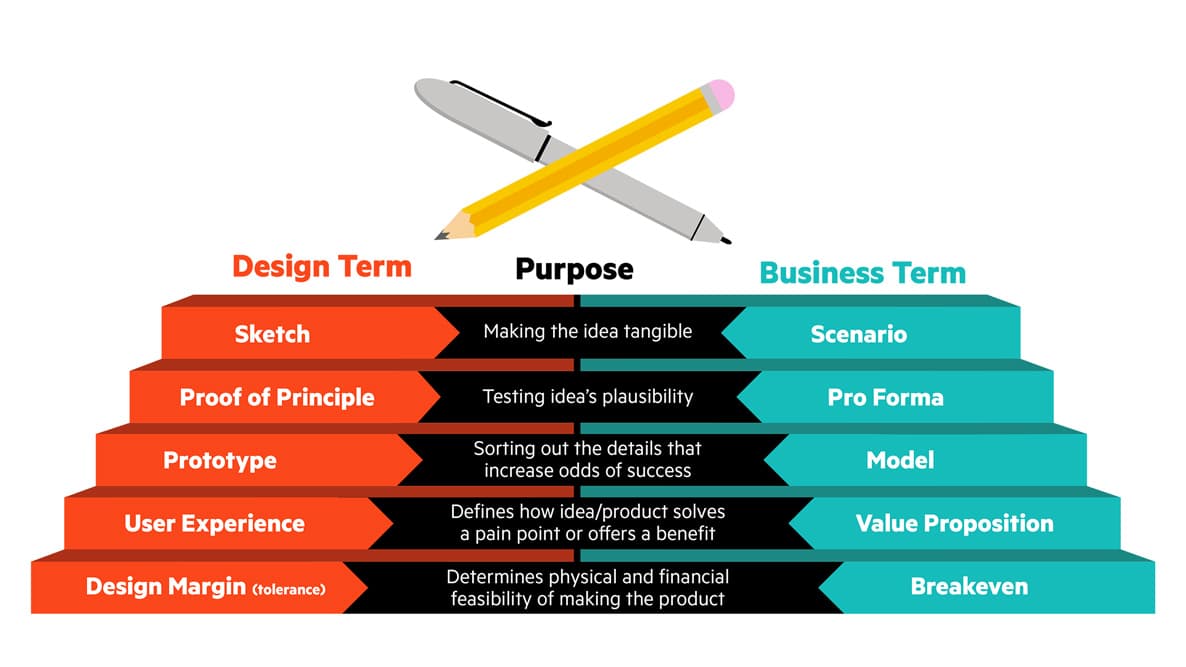You say sketch, I say scenario
Business people and designers have the same goals — launching successful products — they just use different vocabularies.
You say sketch, I say scenario
When I began the first year of my MBA program at a well-known business school, a Facebook was still a real book, printed on paper.
In it, each of us was given a chance to introduce ourselves to our future classmates with a headshot, hometown and three lines of text. Many of my peers used these lines to boast of patents or investment bank experience or perfect GMAT scores. As an undergraduate journalism major and then a marketing manager, I wasn’t typical B-school material and was blissfully ignorant. I used one of my three lines to proudly proclaim how I was voted Most Creative by my high school class. When I first opened our Facebook and compared my listing to everyone else’s, I was so ashamed. All I had to offer was creativity? And I thought that mattered?
Fast forward 15 years. I now work at a design firm as the Director of Business Design, a title I created for myself. One could say I am still a bit out of step among my 60 peers, three-quarters of whom are traditional design professionals — industrial designers, UX designers, mechanical engineers, etc. But in my post-MBA working years, I’ve come to understand one thing: while we believe that business and design speak completely different languages, they don’t. They just use different vocabularies. I wasn’t the foreigner I thought I was in business school. It just took me a while to learn to translate.
Fortunately, I graduated from business school bilingual. I can speak user experience and prototypes as well as value proposition and financial models. You can, too, and without getting an MBA. Why? Business people are designers too. They just use different language and different tools. But the goal is the same—to create the most desirable, most relevant product possible.
Let me show you two of the many ways in which business people and design people use nearly identical tools and measures.
A sketch is worth…exactly one scenario
Designers sketch. Whether they consider themselves good at it or not is irrelevant. Almost universally, sketching is the way designers get ideas out of their heads and into the open. Business people are famously horrible artists. But like a “real” designer, they take an idea and make it real by creating a scenario — something that is not drawn in pencil with lines and curves but with assumptions, constraints and calculations that give the idea a tangible form.
For example, if I were an industrial designer, I may have an idea for a toilet brush for institutional bathrooms that has an extra-long handle and a cone-shaped brush. I would sketch it on my tablet to communicate the essence — and appeal — of this idea to someone else. If I were a business designer, I would create a scenario where the market for institutional-grade toilet brushes is one third of the total toilet brush market. I’d “pencil in” that an extra-long handle would cost .44 cents more per unit. And that each cone-shaped brush could be sold for a .75 cent premium. In my own business-y way, I’d be making that toilet brush real enough to share as well. Instead of communicating the functional value of the toilet brush with a sketch, I’d be sharing its business value. Both are real. And both are important.
You say prototype, I say model….
One of the standard tools of the trade, in design, is a prototype. A designer builds a product with enough basic fidelity to be able to finesse the details of how the item functions and looks. A designer does this to establish the known elements of a product (it has a handle) and iterate on the aspects that are not yet decided (How conical is the brush? How does the handle integrate?). Because a prototype is higher fidelity than a mock-up, most are solved, or known. A designer can focus on refining a single aspect of the product.
Similarly, a model in business terms is a tool that is more robust than a spreadsheet. Using Excel or something similar, a business designer quantifies what is known (standard handle costs .50 cents/unit) and then adds unknown variables (cost for a three-inch versus four-inch diameter brush). Just like a designer fiddling with a prototype, a business person plays with a model to find the combination of product attributes, cost and price that is just right. Both prototypes and models are imperative tools for creativity, which is mandatory for both business and design success.
As a bilingual speaker of design and business, I encourage you to forget everything you think you know about business people and start thinking of “them” as designers, too. I can vouch for the people who like numbers and wear navy blue. They want the same things as designers do – to solve wicked problems, use their creativity, and ensure that good things (including design) succeed out in the world.
